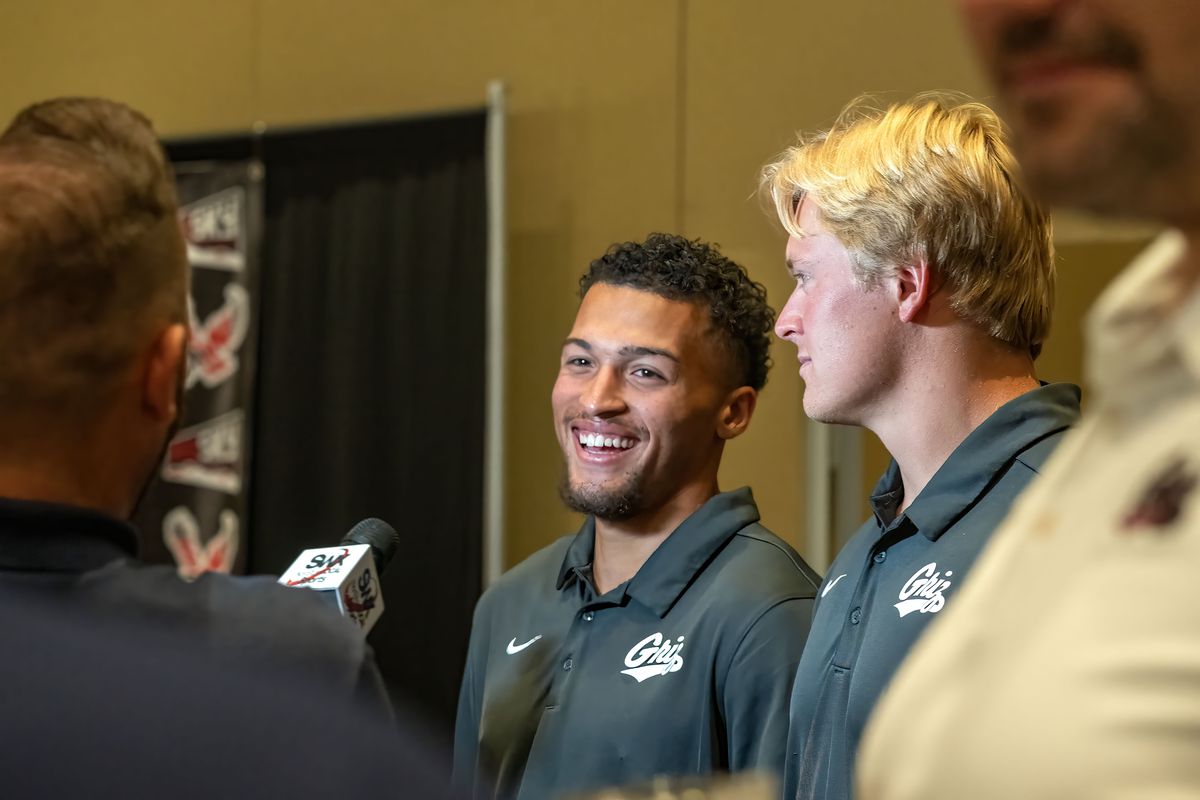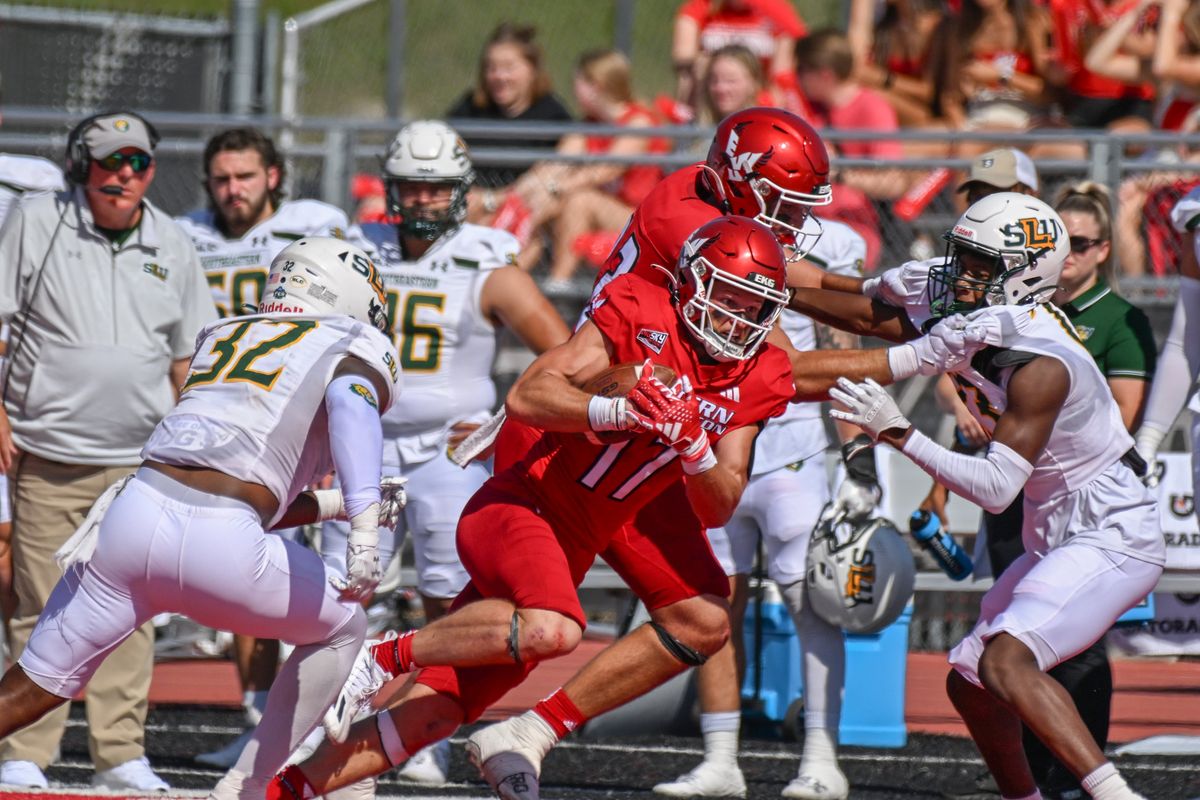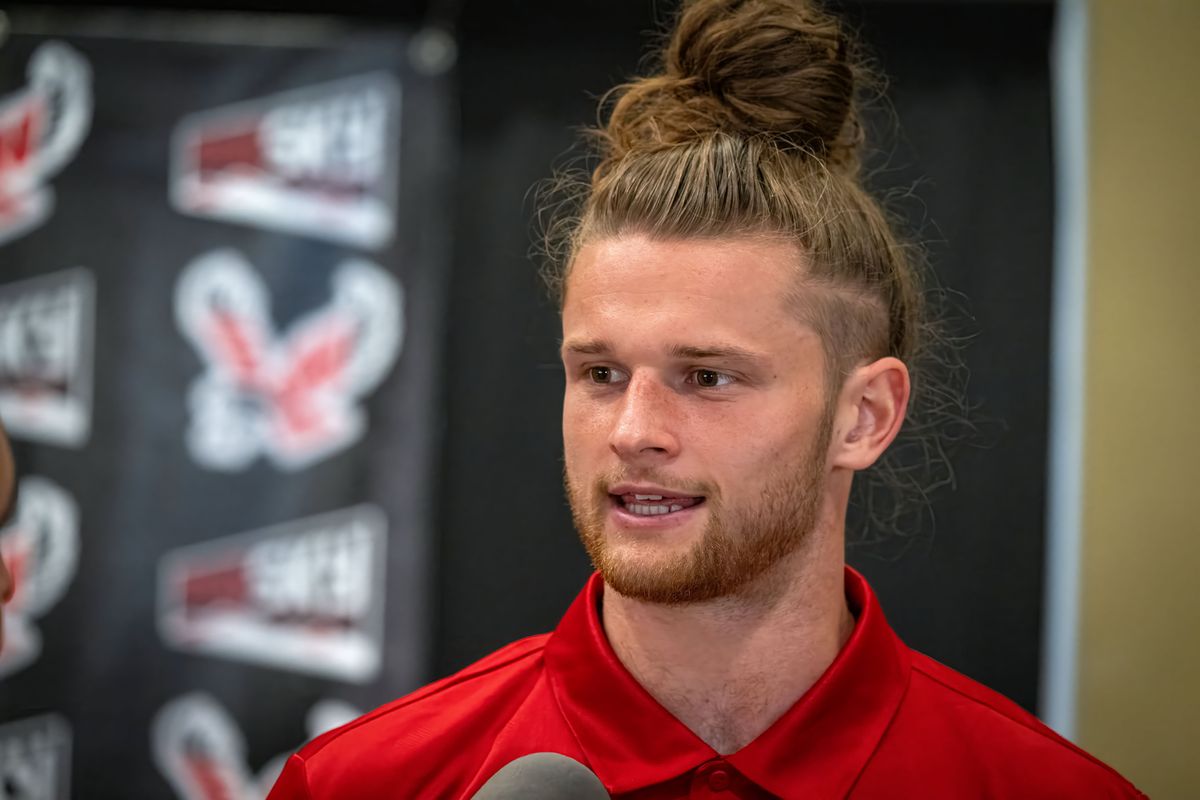Caught in the middle of NIL and the transfer portal, FCS coaches must balance player development – and potential loss – with the instant impact of FBS dropdowns
Eastern Washington receiver Nolan Ulm, center, pictured in a 2023 game against Southeastern Louisiana, has played 41 games since arriving in Cheney in 2021. (Jesse Tinsley/The Spokesman-Review)
When Nolan Ulm first came to Eastern Washington four years ago he was, by his own admission, not all that well-schooled in the game he was there to play.
“I was a great athlete,” the now-senior wide receiver said. “I didn’t know how to play football.”
But Pat McCann, then the Eagles’ wide receivers coach, and then-head coach Aaron Best, who is now in his eighth year as EWU’s head coach, believed in him.
That first year was tough, Ulm said. He would go back to his dorm and tell his friends that football – the practice, the study, all of it – was tougher than he expected.
But Ulm is a man of many sayings, and one of them is that the only failure is quitting. So he wasn’t about to quit or leave.
And yet, every year in college football, there are many who do – for any number of reasons. Some transfer elsewhere. Some stop playing football.
Of the 26 players in Eastern Washington’s 2020 high school class, 17 remained in the program for four years, and 13 of them are still playing this season. That’s possible either by redshirting one year or playing in the first season (the COVID-shortened 2020-21 campaign that didn’t count toward their eligibility).
Across the Big Sky, teams want to see full retention of freshmen classes. It’s better for the programs, they said, and it’s better for the student athletes.
“We’d love to have all of them,” Sacramento State coach Andy Thompson said. “I think that’s been a real success in our program. We’ve had guys in the program multiple years and have gotten their degree from Sacramento State. That’s always the goal.”
Yet getting every freshman to that finish line four (or sometimes five or six) years later is harder than ever for schools at the FCS level.
Few programs can offer lucrative name, image and likeness opportunities, certainly not the kind to compete with those of FBS programs.
Roster space is crunched because the pressure to succeed leads FCS teams to accept transfers from FBS schools at higher rates than they used to. Eastern Washington, as just one example, has 27 transfers on its current roster. In 2020, it had four.
“You have to (take transfers),” said Montana head coach Bobby Hauck, whose program brought in 13 players from FBS schools last offseason. “I don’t think there’s any way around it in this day and age.”
But across the league, the prevailing belief remains the same: The best teams are built around fourth-year and fifth-year players.
Despite the challenges, recruiting, developing and retaining high school seniors is the ultimate goal when coaches build their rosters.
“We want to create an environment where these guys have such a good time that they want to stay, and they want to keep doing it,” said Thompson, a Walla Walla native who played football at Montana. “And also, we (want to) give these guys some expertise. We try to be an expert in the football part, and we try to guide them in life.”
Because in the end, many coaches said, what they do is about so much more than football.
The full process, come full circle
Giancarlo Woods first joined Cal Poly’s football team as a walk-on receiver following his high school graduation in 2020.
His class, across the country, was recruited in the usual timeline because the bulk of that work happened before the COVID-19 pandemic.
Future classes were impacted differently.
Still, Woods got to San Luis Obispo just looking to prove himself.
“I just wanted an opportunity,” he said. “I felt like I had the talent and I just needed a place. And coach (Paul) Wulff and coach (Beau) Baldwin, when he was here, allowed me to do that.”
Baldwin, the former EWU head coach, was then Cal Poly’s coach and has since been replaced by Wulff, also a former EWU head coach. Despite the coaching change and the Mustangs’ 3-21 Big Sky record the past three years, Cal Poly has 14 current seniors on its roster who have spent their entire career in the same program. Among the Big Sky’s 12 programs, only UC Davis has more, with 23.
“It’s crazy that we’re going into our fifth year,” Woods said. “Seeing guys like (Elijah) Ponder come in as skinny freshmen and now look at him. He’s an All-American. It’s cool to see the full process come full circle.”
The Big Sky Conference’s recruiting niche is often the overlooked or not -quite -developed player, people like Woods, Ponder and EWU’s Ulm. And so when coaches are on the recruiting trail, development is what they have to pitch to players and families.
“You try to project them physically, mentally and emotionally the best you can,” Montana State head coach Brent Vigen said. “You try to lay out that plan the best you can.”
Vigen, who coached previously at FCS powerhouse North Dakota State, said he tries to point recruits to players who are a relative development story on the team already. The more you can demonstrate what that development looks like, Vigen said, the easier it is for them.
“Ultimately what we want three or four years in is a young man who says, ‘this place made me,’ ” Vigen said. “(They say) ‘I am devoted to them, they are devoted to me, and I don’t want to think about leaving.’ “
That’s not what happens to the fullest extent anywhere, Vigen acknowledged, but that sort of investment, if it is developed, makes it harder for players to leave early.
Still, external development plans can only do so much. Players have to buy into their own development, coaches said. Players, in short, have to want to do the work to be successful.
“A driven person is critical,” NAU first-year head coach Brian Wright said. “(They need to be) somebody that you’ve seen work hard and have success in other areas of life. What kind of student are they? What kind of competitor are they?”
Weber State second-year head coach Mickey Mental put it succinctly: “I want guys that want to play now.”
Finding a role
Yet few players actually are capable of doing what Mental said, which isn’t to say he’s not realistic. What he’s after is a certain mentality.
“You only have so many years to play this great game, so get your butt on the field,” he said. “And that’s the expectation. That trickles down from seniors to juniors and sophomores and freshmen. What’s your role on our team, and how are you going to execute that role to the highest standard each and every day? What’s your value to our program?”
Weber State doesn’t have many of those four-plus-years-in-the-program guys this season – just six of them.
Retention isn’t a perfect way to measure program success, considering coaching changes, program success and many other factors play into athletes’ decisions to go elsewhere.
But there are still strategies coaches lean on to retain players in their program, because they recognize the value of creating and perpetuating a culture.
“Every year since I’ve been here, we’ve had a group of senior linebackers who were super influential and hard-working,” Montana senior linebacker Ryan Tirrell said. “You take stuff from everybody. I take stuff from them that resonates with me.”
The arc of Tirrell’s career at Montana is a fair representation of what the program looks for. He redshirted his first season, and then he spent two years making his mark on special teams while transitioning into more reps at linebacker.
In 2023, as a redshirt junior, Tirrell played in all 15 games – Montana lost in the FCS title game – and made seven starts while making the fourth-most tackles on the defense (62).
This season, he’s a presumptive starter and a leader on the team.
“We really believe in recruiting high school guys and redshirting them,” Hauck said. “We’re pretty forthright about how we want to develop them and bring them along. We tell that to parents. (We tell them) you’re going to give us your kid, and we’re going to give you back a well-developed young man who is ready to have success.”
It’s a similar story for Montana receiver Keelan White, who saw minimal game action his first two years on the team, playing as a receiver and also returning punts. In 2023, he led the Grizzlies with 798 yards on 54 catches.
“It takes a lot of hard work. You’ve got to get better every day,” White said. “You’ve got to be coachable. You’ve got to show your coaches that you are getting better every practice. If you’re developing bad habits, you’ve got to break those.”
Coaches also lean into the strengths and opportunities unique to their particular place. Both Vigen and Hauck said they rely on stocking the roster with Montana natives to help perpetuate the culture of the programs and the campus communities.
Where there is a winning tradition, coaches certainly recruit on that.
But not overlooked is the academic aspect: These athletes are given the opportunity to be college students, many of them on full scholarship at particularly rigorous schools. That’s something UC Davis head coach Tim Plough said he emphasizes with players.
“Being a student at Davis is hard enough,” Plough said. “Doing football and being a student is a full-time gig.”
In recognition of that, Plough said the team brings freshmen on campus at the end of June and has them take a class in the summer to get used to the rhythm and the rigor. Once football begins, they have access to various academic supports – all Big Sky athletes do, to varying degrees – and Plough emphasizes that the point is to graduate with a degree.
Among Big Sky schools, Cal Poly and UC Davis had some of the fewest total transfers in and out. The Mustangs had nine, and the Aggies 12, according to HERO Sports’ annual tracking.
(Eastern’s total movement of 11 transfers, nine in and two out, was also among the least.)
“You just have to decide that you want to compete in class in the same way you do in football,” he said.
Heading into this season, no Big Sky school has more of those four-year-plus seniors than Davis, which has 23. Cal Poly’s 14 are second-most, followed by Montana (13), Montana State (12) and Eastern Washington (12).
“(Fifth-year seniors are) invaluable,” said Wright, whose program this year has just two who have been in Flagstaff all five years. “And we’re losing that right now in college football with guys transferring so quickly. I think the programs that can sustain that, and really identify the right people and then develop them into your program and get them through, I think you’re going to have a lot of success on the field.”
No ‘two -hour’ speech to keep players
While it may not happen particularly often, Big Sky players are given the opportunity to transfer to FBS programs. After last season, for example, 49 Big Sky players transferred to FBS schools. Idaho and Portland State each had the most with seven.
Eastern Washington had the fewest in the league, losing just one: Jakobie Keeney-James to UMass. Montana and Cal Poly each lost two; Davis lost three. Every other program saw at least four players transfer up to an FBS team, according to HERO Sports’ annual list of such movements.
Despite its lack of victories and its multiple coaching changes, Northern Colorado lost four players to FBS schools last year. That includes offensive lineman Austin Lawrence (Washington State) and quarterback Shea Kuykendall.
But second-year head coach Ed Lamb’s approach to it is, if players want to leave in search of that, they can go.
“To put it in Shakespeare terms, I’ll give them coins to depart,” said Lamb, who coached Southern Utah to a 45-47 record and two FCS playoff appearances from 2008 to 2015. “We don’t want to have a team of people who think there’s some other place better. The reality is, if you’re looking for bigger stadiums, more winning tradition, more NIL money, it’s out there.
“We need guys who are trying to accomplish something special. Make no mistake, if Northern Colorado can win the Big Sky championship, that’s more special.”
Last offseason Big Sky schools collectively brought in almost twice as many players from FBS schools (94) than they themselves lost to FBS schools (49). Every Big Sky program except three – Idaho and Cal Poly, who accepted three FBS transfers, and Montana State, who took in four – brought in at least six players who spent last season at an FBS program. Northern Colorado (10), Montana (13) and Northern Arizona (14) added the most from FBS teams.
There were also about as many players who went from a Big Sky school to another FCS program (40) as there were players who left other FCS programs for a Big Sky team (36).
Six even went from one Big Sky program to another: Abraham Williams (Weber State to Idaho), Justice Jackson (EWU to Idaho State), Kade Cutler (Montana State to Montana), Eddy Schultz (Cal Poly to Portland State), Daniel Meyer (Cal Poly to UC Davis) and Murvin Kenion (Idaho to Sacramento State).
Big Sky coaches as a whole aren’t particularly focused on re-recruiting players when the season ends. They’ve calculated that by then, athletes have a body of coaching and experiences that will help them come to a decision; prodding them isn’t going to matter much.
“I don’t believe in recruiting your locker room while they’re there,” Best said. “I wish success on everybody that leaves the program whether it’s for eligibility or opportunity. It’s not some two -hour speech to keep guys.”
Building up a healthy, truthful rapport with athletes serves to prevent transfers in the long-term more than anything coaches can say in November or December. Vigen said being honest and truthful is something they at Montana State try very hard to be at every step of the process, from recruiting all the way through a players’ four or five years in Bozeman.
“Ultimately when guys are provided opportunities, you hope that we’re the first ones they come to for advice,” Vigen said. “Some of these opportunities, good or bad, make sense. I hate to say it, but that’s the reality of it.”
Plough said if players at Davis receive those chances to transfer, he sees that as a good sign – especially for the players who already graduated from Davis with a degree.
“I hope that a lot of schools want to pay our players,” he said. “That means I am doing a good job and we’re developing them. If you can graduate from Davis and have that degree, and you feel like you’ve got to go, it’s not my place to stand in the way.”
In the end, however players come to programs, be it as freshmen or as transfers, coaches are looking for many of the same traits.
They want players with discipline. They want players with high standards for themselves. They want players who learn from others.
They want players like Nolan Ulm. Like Giancarlo Woods. Like Keelan White.
Fill a program with talented football players who possess those traits, who can perpetuate a positive culture, and Big Sky coaches will take them, teach them and develop them.
Retention, in their estimation, is a byproduct of that process.
“The guys that have success are really good at focusing on the things they can control and not worrying about where they are on the depth chart,” Wright said. “They just go to work every day, identify what their weaknesses are and identify how they get better.”






